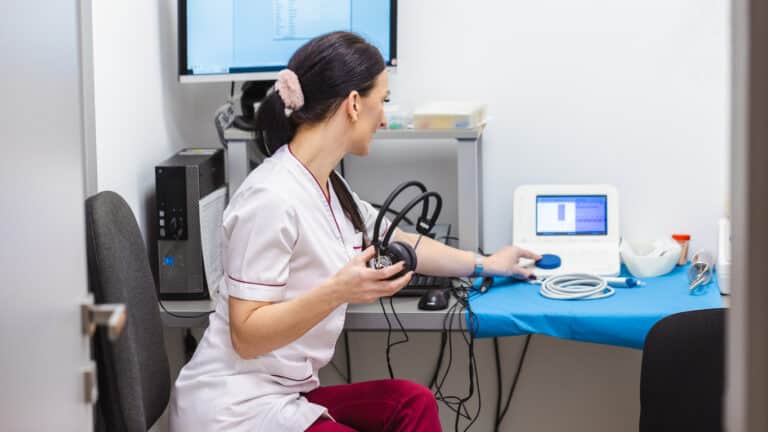Studies suggest that people wait, on average, seven years after they begin to suspect they have hearing loss to seek treatment. If you suspect you have hearing loss or are beginning to develop hearing loss, your first step is a hearing evaluation with an audiologist, and it’s a critical first step. The sooner you get your audiogram and a diagnosis, the so oner you can get reconnected to the world of sound and communication.
oner you can get reconnected to the world of sound and communication.
Step One: Discussion About History
Before anything else, you and the audiologist will sit down and discuss your hearing health and all its facets. You will discuss the challenges you’ve had with hearing lately and any other hearing health history you may have, and you may also discuss your medical history, lifestyle, work, medications you’re currently taking, exercise levels and diet, among other things. Hearing is complex, and hearing loss can result from a variety of causes. This discussion will provide your audiologist with valuable insights into your hearing health and its underlying factors.
Step Two: Otoscopy
Next, the audiologist will perform a visual check of your ears. They’ll use an instrument called an otoscope to see if there is anything in your outer ear or ear canal that could impact your hearing, such as earwax buildup or damage to your eardrum.
Step Three: Diagnostic Testing
At this point, you’ll be seated in a soundproof room and undergo some hearing tests. There are several tests an audiologist can perform at this phase, depending on your hearing loss:
- Pure tone testing has you listen for sounds at various pitches through headphones, and you’ll click a button or raise your hand when you hear the tone.
- Bone conduction testing is similar to the pure tone test, but it projects sound to the inner ear instead of through the outer ear through headphones.
- Speech testing is a more nuanced test that discerns how well you can hear speech and spoken communication in various settings, testing a more realistic hearing scenario.
- Tympanometry testing tests how well your eardrum moves when hit by a sound wave.
- Acoustic reflex testing determines where in the ear your hearing issues may originate by measuring muscle contractions in the ear in response to sound.
- Auditory brainstem response (ABR) testing is similar to acoustic reflex testing, but it measures brainwave activity instead of muscle contractions.
- Otoacoustic emissions (OAE) testing measures the response of an organ in your inner ear called the cochlea, which is critical to transmitting hearing information to the brain.
Depending on your hearing loss and what you discussed with the audiologist previously, you may do one or many of the tests listed above. Taken all together, they will paint a picture of what you can hear well, what you can’t hear well, what the root cause may be and what type of hearing loss (sensorineural, conductive or mixed) you may be experiencing.
Step Four: Results
You will get the results from your hearing evaluations right away, and your audiologist will go over them with you. The results will be laid out on a chart called an audiogram, and it will show how well you perceived pitches and volumes. From here, your audiologist will be able to make recommendations on treatment.
If you think you have hearing loss and want to start treatment, call SH Audiology today to set up an appointment for a hearing test. We’re excited to begin your journey to better hearing health with you.
Learn More
